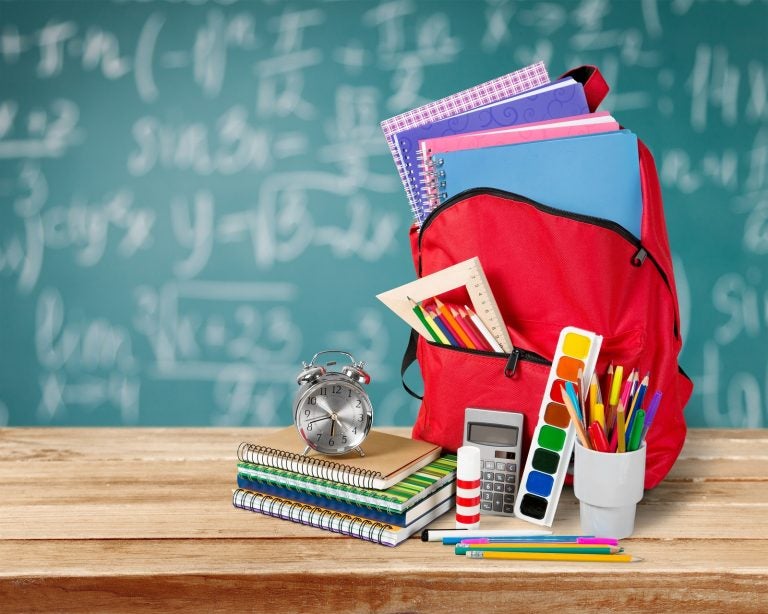5 ways to ease back into your school schedule

Back school backpack and supplies. (Photo Courtesy/BigStock)
That time of summer is here…when the stores are filled with school supplies, bus schedules and teacher assignments are announced and kids and parents alike sense that summer’s relaxed schedule is about to give way to the more structured routine of school, homework and other activities.
Children and adults react to structure and routine in different ways; many of us thrive in routine and look forward to the beginning of the school year. For many children with cognitive disabilities such as autism, the unpredictability of summer’s unstructured days are challenging and back to school time is preferred. For other kids and teens, letting go of summer is especially hard and planning for the transition back to school can make the experience better for everyone.
As my children have gotten older (they’re ages 15 and 12 now), I’ve learned more about what each of them needs to have a successful transition back to school—and how preparing the whole family a couple of weeks in advance for the new schedule can really pay off. Here are 5 tips that have helped my family transition back to school over the years—I’d love to hear about the strategies and tips that have worked well for your family in the comments below:
Get Some Sleep: Many of us parents are looser with bedtime during the summer months. When it’s light outside at 9pm during mid-summer, it can be challenging to convince even tired kids that it’s bedtime. Starting to adjust bedtime a few weeks in advance of the first day of school can help a lot; even if you do so in 5-10 minute increments. Bedtime can also be the time when many kids feel and express their anxiety and concerns—so build in extra calming techniques like taking a bath before bed, diffusing calming essential oils or just taking a few extra minutes to listen to your kids worries. And keep in mind that many kids will be tired and cranky during the first few days of school regardless of sleep schedules—it may take a few weeks to get into a pattern that works optimally for rest.
Ease Into Routine: Besides getting to bed on time, kids may need practice with getting ready in the morning or making time for homework after school. Practice laying out clothes the night before and getting up and getting dressed. A checklist works well for many kids—list the things that need to happen between waking up and getting out the door. Little rewards can be very motivating to many kids. Build in more reading time and cut down on screen time in the weeks leading up to school to help your child get back into the homework routine.
Visit and Do Practice Runs: If your child’s going to a new school, make time to visit, walk the halls and play on the playground before the first day of school. Even if your child is returning to the same school, just visiting to play on the playground or drop into the office to say hi can help kids feel less anxious on the first day back. Practice walking to and from the bus stop or walking your route to school. Most teachers return to the classroom before the first day and if you have any special concerns related to your child, send a friendly email to their teacher and be pro-active in setting up a time to talk. Parents who have children with IEPs or 504 plans should absolutely feel like you can reach out to teachers and establish a communication routine in advance of the first day.
Get Organized: For many kids, picking out new school supplies and clothes is a motivator for getting back to school. For parents, back to school shopping, packing lunches, filling out paperwork and adding activity schedules to our calendars all takes time. Allow extra time in your schedule to take care of these tasks and know that you may feel extra busy and a little drained during the back to school phase. Back to school is also an expensive time–if your family needs financial support or assistance to get your kids the clothes and supplies that they need to start off the school year, there are great local organizations like Cradles to Crayons that are available to support you.
Listen: Any change comes with lots of feelings—excitement, worry, anticipation, fear. Know that kids of all ages may be experiencing a mix of these feelings as they prepare to head back to school. Try to listen to their concerns without judgment—and encourage your kids to draw or write about what they’re feeling, too. Many times the intensity of their feelings will dissipate once the routine of the school year falls into place. Other kids who struggle more with transition and change may need extra support from a guidance counselor or therapist to process their feelings.
I am wishing you and your family a very successful transition back to school!
WHYY is your source for fact-based, in-depth journalism and information. As a nonprofit organization, we rely on financial support from readers like you. Please give today.




